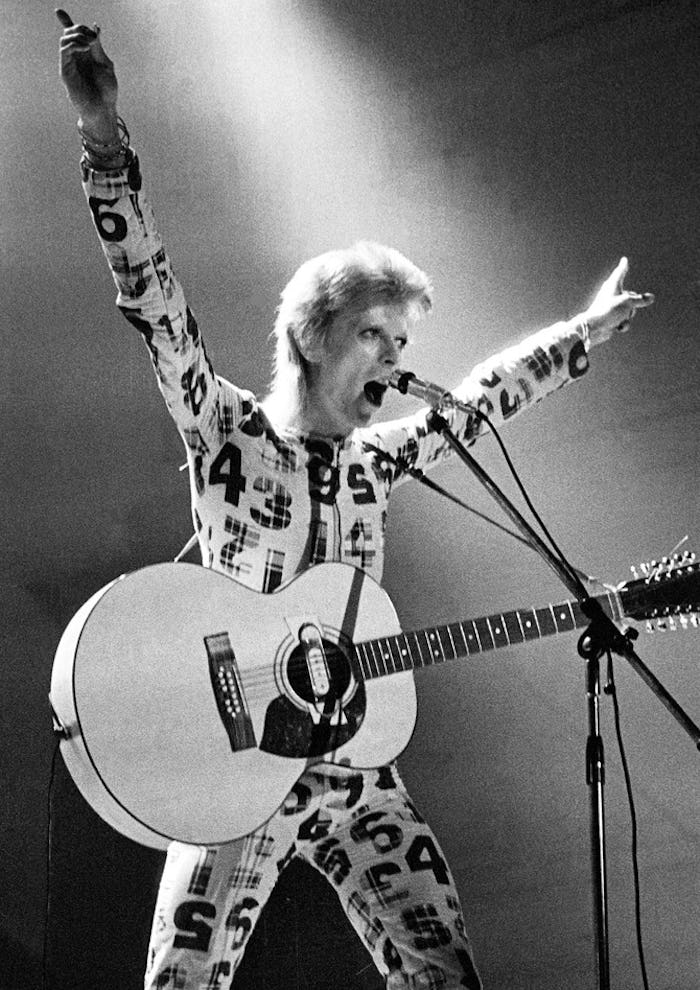Entertainment

David Bowie's 7 Most Iconic Looks, Because No One Knew How To Reinvent Himself Quite Like Bowie
As the world reeled from the loss of David Bowie on Monday, fans were looking back at his incredible career to remember some of his greatest moments. But, when it comes to Bowie, it's not enough to look just at his music — his envelope-pushing, clothes-as-art fashion statements are just as important a legacy. David Bowie experimented with his look a great deal throughout his decades-long career, and spawned entire sub-genres of artistic expression. But there are some moments that are so iconically Bowie that they will always be remembered even though he's gone. Bowie's most iconic looks will help him be remembered as a sort of other-worldly artist — he and his music sometimes seemed to come from another planet.
From his late '60s emerging androgyny, to his unapologetic, gender-bending '70s glam rock catsuits and tights, and his unforgettable alter-egos Ziggy Stardust, Aladdin Sane, and The Thin White Duke, David Bowie was clearly not afraid to push the boundaries of what was considered appropriate. But according to the Huffington Post, Bowie's ever-changing looks weren't just about fashion, but about finding a way to leave himself behind:
Offstage I'm a robot. Onstage I achieve emotion. It's probably why I prefer dressing up as Ziggy to being David.
It's pretty much impossible to ever definitively narrow down Bowie's best looks, but here are 7 of the most iconic ones that come to mind now that he's gone.
His 1960s Androgyny, Before Androgyny Was Accepted
Has anyone ever been able to pull off an androgynous look as flawlessly as David Bowie? We saw the precursor to his later gender-bending looks in the 60s, as he embraced his thin face and sharp features and grew out his hair.
The Man Who Sold The World
On the cover of David Bowie's third album, "The Man Who Sold The World," he took androgyny one step further and wore a maxi dress (or, at least he did on the U.K. cover — the U.S. version featured a less risque, cartoon-like drawing). The dress, according to the Huffington Post, was designed by Michael Fish, who specialized in so-called "man dresses."
Naturally the image of Bowie in a dress raised eyebrows at the time, but even now, that would be considered a bold, incredibly subversive move, showing just one of the many ways Bowie was ahead of his time.
When He Became Ziggy Stardust From Outer Space
It's almost impossible to think of David Bowie and not conjure an image of his most famous alter-ego, Ziggy Stardust. The New York Daily News called Bowie's bisexual space alien persona "the crown jewel of the whole glitter-rock movement," and it's easy to see why, thanks to his signature bright red hair, eye-patch, and, of course, his bodysuits and intergalactic space makeup. NBC News noted that while he "was seen by many at the time as overly effeminate," his bold persona held incredible importance during a time when attitudes about sexuality were just beginning to evolve.
His '70s Yamamoto & Artistic Flair
David Bowie took a particular interest in the work of Japanese fashion designer Kansai Yamamoto in the '70s, and it seemed like a match made in heaven. Yamamoto told Dazed, “David Bowie and I combined the worlds of seeing and sound" when they worked together, and the result was legendary.
When He Wore High Heels To Perform

David Bowie wore platform heels as Ziggy Stardust, but, even when he mellowed out in the '90s, he didn't shy away from women's heels. Bowie opted to wear black heels with his Thierry Mugler suit to the 1996 Brit Awards, too.
The Thin White Duke
Just when it seemed like David Bowie was all glitter and glam rock, he reemerged as the Thin White Duke. This look was a departure for Bowie, with short, slicked hair and tailored shirts and vests, but it did hint at what his later looks would closer resemble in the '80s, '90s and beyond.
His Dark, Forboding Look For 'Blackstar'
There was nothing that seemed necessarily iconic about Blackstar at first, but with the understanding now that his most recent release was always intended to be his last — his final musical sign-off — it will forever hold incredible meaning. The video for the album's single, "Lazarus" is our last look at Bowie, and it's filled with imagery of death and illness. According to the New York Daily News, Bowie's long-time friend and producer Tony Visconti called the album the singer's "parting gift," and images from it will long be remembered as an icon's final goodbye to a world that had no idea it was coming — yet another example of Bowie leaving a lasting mark on pop culture.
It's difficult to think of a musician who was able to marry fashion, art and music together so flawlessly — and in so many blatantly different ways. His work was an inspiration not only to his fans, but to all of the musicians who came after him and who were inevitably influenced by his groundbreaking style.
Images: Ian Dickson/Redferns/Getty Images